Yoga For Gardeners: How Your Yoga Practice Can Help With Your Gardening Game
Even if your garden is small, the amount of physical work it can take, especially in the spring or at harvest, can be astounding. Bending, lifting, lifting and twisting, bending, lifting and twisting are all complex activities for the body that often don’t go down well after a long week at a desk. Or perhaps you are more like me, a landscaper or working on a farm, finishing plantings under the threat of weather, always moving, overworking, and pushing to finish during a short season. Ah, we can overwork! After a long day in the garden, my sister calls it “gettin’ a hurt on”.
So why don’t we naturally stretch and relax our bodies regularly as other animals do? If you are working with your body or just living in one, it makes sense to understand how it works.
It turns out that muscles are only designed to contract. Stretching is optional. Muscles are striated by fascia fibers that hold the body’s shape. If you liken muscle tissue to rubber, then fascia would be more like plastic. The way you hold your hips, shoulders, and head, day in and day out, will be held firmly in place by the body’s fascia system. The facia also shortens and dries out as the muscles contract through use and dehydration. Over time, this is called old age.
Yoga For Gardening
Yoga postures are a simple way to systematize stretching and relaxation to help the body recover from all sorts of things, especially gettin’ a hurt on in the garden. It was developed by ancient humans, long before mechanization and spandex, because they needed to use their bodies to do everything. Developments in yoga postures since its emergence from ancient India have brought us restorative yoga. This practice describes long-held, fully supported yoga postures that help the body open, release, rest, and relax. It is at the top of the list of things to look into during gardening season.
Work Habits That Transfer Directly From Yoga Practice
- Improved mindfulness, taking time to position your body, using legs to lift, etc.
- Moving with the breath, lifting during exhalation
- Training parts of the body to work independently as well as in unison
- Better balance and extension
- Improved endurance
- Awareness of when you are tired and valuation of resting
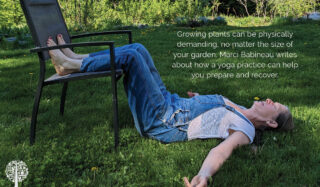
The body retains the yoga practice over time. It remembers how to stretch, lift, and pace. Practicing conscious movements protect the body from accidents. Slowing down to take a breath before lifting increases strength.
It is helpful to think about the activities you will be doing in a work period and try to match your stretching to them. I can’t teach you yoga in 850 words, but you can complete the following moves in about 15 minutes, keeping you happier in the garden for longer. And hey, isn’t that what it’s all about?
Gardening Warm-Up
Half-standing forward bend
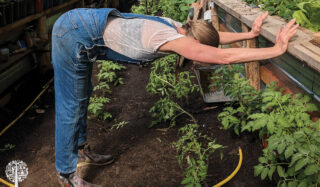
Begin by identifying something stable in your work zone about hip height. Place your hands there, shoulder width apart, then step your feet back, placing them hip distance apart. Your legs and torso should make a right angle, if possible. If you are using a wall, you can press your hands flat to stretch the wrists and fingers. Then, outer rotate the arms so the shoulders open around the neck. Your head stays at arm height. Use the thigh bones to draw the pelvis away from the shoulders. Breathe and relax where you can, keeping your legs and arms activated.
Leg stretches
Leg stretches are done from the same place as the previous posture. Take one leg forward and the other back. The feet should be on the ground, hips squaring. The torso can be up with the chest lifted or lowered like in the previous posture. Hug the thigh bones toward each other. Repeat on the other side.
Forward bend with hands under feet
This pose is quite therapeutic for overworked hands. You want to step the big toes up toward the wrists. Keep the knees bent as much as needed.
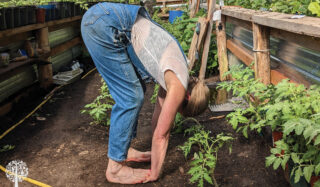
Squatting
Squatting strengthens the knees and opens the hips. Find something to hold onto to anchor you. Bend your knees and lower your hips. If your heels don’t reach the ground easily, adjust your distance from the anchor so they can. Bring your torso between your legs and relax your head toward the ground.
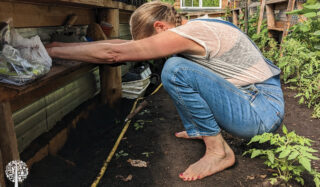
Tree pose
Tree pose for balance can be practiced by putting your foot on the inside of your ankle, calf, or upper inner thigh. Press the foot into the leg and the leg back into the foot. Ground the lower body as you lift and extend the arms overhead. Soften the eyes and focus on something.
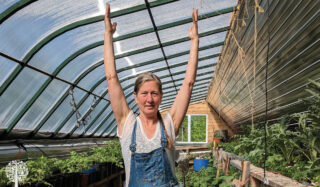
Gardening Cool-Down
Child pose
Take your knees wide apart and your big toes together, laying your torso forward between bent knees and taking the head to the floor.
Rest
Rest with your legs on a chair (or hammock).

During all postures, breathe slowly through the nose. All postures can be held for 5-10 breaths. If you want to get more serious about yoga, find a small, quiet class and bring a mat. In the meantime, keep stretching, breathing, and gardening!